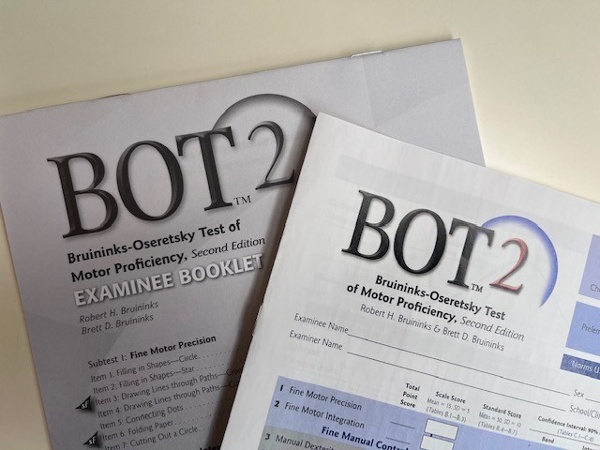BOT 2 Assessment

The BOT-2 (it's full name is the Bruininks-Oseretsky Test of Motor Proficiency – 2nd Edition) is an individually administered test designed to provide Occupational Therapists with a reliable and efficient measure of fine and gross motor control skills.
It is standardised from the ages 4 years through to 21 years and therefore can be used to compare a child’s motor performance against the motor performance of their peers – this way we can gauge the impact that any motor difficulties a child has on their performance in everyday tasks.
The test provides a guide of motor performance but has to be interpreted by a therapist in the context of other issues that may impact on performance such as learning difficulties, concentration issues and behaviour issues.
It is frequently used as one of the diagnostic tools for Dyspraxia (Developmental Co-ordination Disorder – DCD).
The test is devised of eight subtests:
- Fine motor Precision
Assesses precise control of finger and hand movements
- Fine Motor Integration
Assesses a child’s ability to integrate visual stimuli with motor control
- Manual Dexterity
Assesses reaching and grasping and bimanual (two hands) with small objects
- Bilateral Co-ordination
Assesses body control and sequential and simultaneous co-ordination of upper and lower limbs.
- Balance
Assesses motor control skills that are integral for maintaining posture when standing, walking or performing other common activities.
- Running Speed and Agility
Assesses running speed and agility!
- Upper-Limb Co-ordination
Measures visual tracking with co-ordinated arm and hand movements
- Strength
Measures trunk and upper and lower body strength
These subtest are then categorised:
Results:
The results for each category are generally presented as Percentile Ranks.
|
0-5th Percentile indicates a definite motor difference from the general age population |
|
5-15th Percentile indicates a borderline motor difficulty |
|
Above 15th Percentile is considered within normal range of motor skills for their age. |
The child is also given a Total Motor Composite Score – A single overall score which is a composite of all the subtests.
The BOT-2 also allows us to use a descriptive category for each individual subtest:
The BOT-2 can also give age equivalents for each of the subtests - these however are less useful and may not be reported.